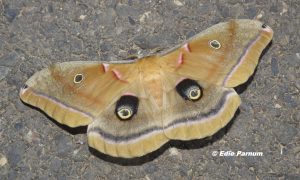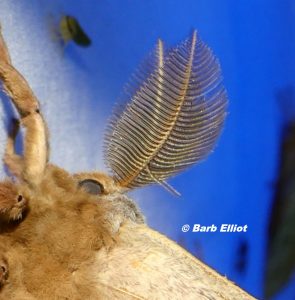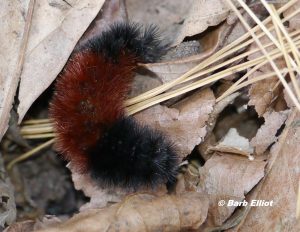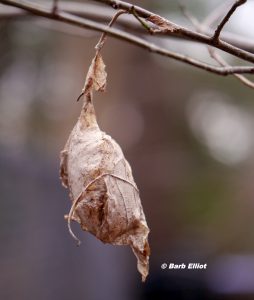By Edie Parnum
A Polyphemus moth alighted on my walkway. It was August 2016, and I had just moved to a retirement community. This cinnamon-colored giant silk moth had a wingspan of 4 1/2 inches. Each hind wing had a large eyespot highlighted with yellow and blue. It’s named for Polyphemus, the one-eyed Cyclops, who was blinded by Odysseus. Although I’m a “moth-er”, I had never seen this handsome moth before.
This summer I acquired two Polyphemus caterpillars at Mothapalooza, a mothing
conference. They survived the 9-hour ride from southern Ohio. Once home, I fed them White Oak leaves from my community’s wooded area. They ate voraciously and pooped continuously. (Scientists call the excrement frass.) Once or twice a day I cleaned out the mesh cage and supplied them with fresh leaves. After two weeks, they stopped eating and formed their cocoons.
Twelve days later, a beautiful Polyphemus adult emerged. I knew she was a female because she had unfeathered antennae. Some friends and I released her at dusk.
Off she flew beaming out her pheromones to attract a mate. Two days later a male emerged from the second cocoon. We released him, too. Using his feathered antennae, he can “smell” a female’s pheromones from miles away.
These two moths (or others of their species) will meet up and mate. They will not eat. Their sole job is to mate. The fertilized female will lay her eggs on an oak, willow, maple, or birch.
Her eggs will hatch and become caterpillars. Birds, mammals, and other insects will eat most of them. Miraculously, a few will survive. The cycle of life will continue—cocoon, adult moth, mating, egg laying, tiny caterpillars, big caterpillars, and cocoon again. This will happen over and over, as long as we have wooded areas or yards with the essential native trees to support them.
Fall can be a good time to look for Polyphemus and other caterpillars. Many caterpillars leave the host plants where they’ve been feeding and start walking. These “wanderers” are looking for a suitable place to overwinter. Many will spend the winter in leaves on the ground; others will spin a cocoon attached to a twig.
A Polyphemus moth cocoon could spend the winter in your own yard. Never mind the cold. Go out into your yard and examine the bare branches of your native trees and shrubs. In 2012 Barb Elliot found a Polyphemus moth cocoon on a Spicebush twig. She told her story on our blog: https://backyardsfornature.org/?p=87, “A Magnificent Moth”. Maybe you, like Barb, can find a Polyphemus or other cocoon. At all times of the year, we can look for signs of nature, both active and dormant, in our backyards.





